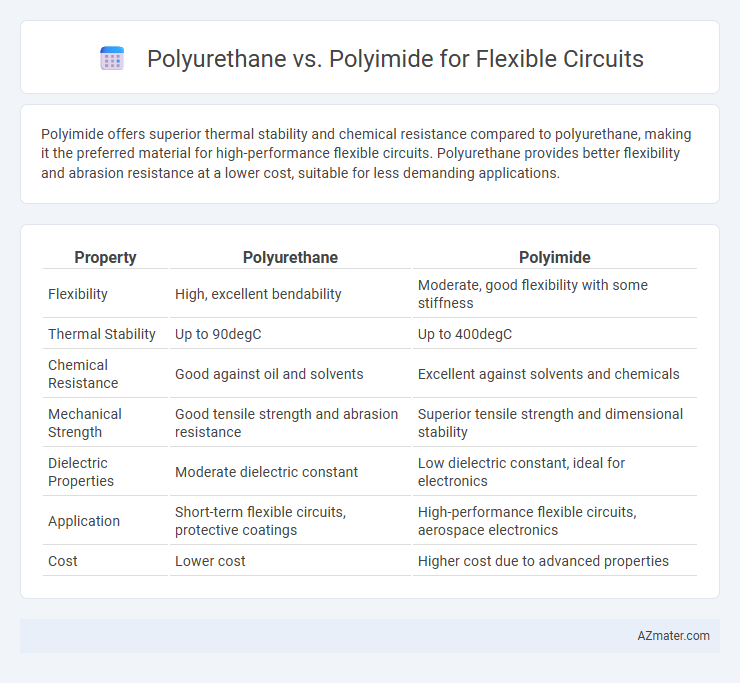Polyimide offers superior thermal stability and chemical resistance compared to polyurethane, making it the preferred material for high-performance flexible circuits. Polyurethane provides better flexibility and abrasion resistance at a lower cost, suitable for less demanding applications.
Table of Comparison
| Property | Polyurethane | Polyimide |
|---|---|---|
| Flexibility | High, excellent bendability | Moderate, good flexibility with some stiffness |
| Thermal Stability | Up to 90degC | Up to 400degC |
| Chemical Resistance | Good against oil and solvents | Excellent against solvents and chemicals |
| Mechanical Strength | Good tensile strength and abrasion resistance | Superior tensile strength and dimensional stability |
| Dielectric Properties | Moderate dielectric constant | Low dielectric constant, ideal for electronics |
| Application | Short-term flexible circuits, protective coatings | High-performance flexible circuits, aerospace electronics |
| Cost | Lower cost | Higher cost due to advanced properties |
Introduction to Flexible Circuit Materials
Polyurethane offers excellent flexibility and abrasion resistance, making it suitable for flexible circuit substrates requiring durability and repeated bending. Polyimide demonstrates superior thermal stability and chemical resistance, ideal for high-temperature applications in flexible electronics. Choosing between polyurethane and polyimide depends on the specific mechanical, thermal, and environmental demands of the flexible circuit design.
Overview of Polyurethane in Flexible Circuits
Polyurethane in flexible circuits offers excellent abrasion resistance, flexibility, and chemical stability, making it a preferred encapsulant and protective coating. Its ability to maintain mechanical integrity under repeated bending and thermal cycling supports long-term circuit reliability. Polyurethane's superior dielectric properties enhance electrical insulation while preventing moisture ingress and environmental damage.
Overview of Polyimide in Flexible Circuits
Polyimide is a high-performance polymer widely used in flexible circuits due to its exceptional thermal stability, mechanical strength, and chemical resistance. It enables circuits to withstand extreme temperatures, from -269degC to 400degC, making it ideal for aerospace, medical devices, and automotive applications. Its excellent dielectric properties and flexibility support complex circuit designs with enhanced durability and reliability compared to polyurethane.
Key Material Properties: Polyurethane vs Polyimide
Polyimide offers superior thermal stability withstanding temperatures up to 400degC, making it ideal for flexible circuits exposed to harsh environments, while polyurethane generally tolerates lower temperatures around 150degC. Polyimide exhibits excellent chemical resistance and dimensional stability, crucial for maintaining circuit integrity during flexing and exposure to solvents. Polyurethane provides higher flexibility and elasticity, enhancing durability in applications with frequent bending, but polyimide's combination of mechanical strength and electrical insulation remains preferred for high-performance flexible circuit substrates.
Thermal Resistance Comparison
Polyimide exhibits superior thermal resistance compared to polyurethane, typically withstanding continuous operating temperatures up to 400degC, whereas polyurethane generally tolerates temperatures only up to 150degC. This makes polyimide the preferred material for flexible circuits exposed to high-temperature environments such as automotive or aerospace applications. Polyurethane, while less heat-resistant, offers better flexibility and abrasion resistance for lower-temperature uses.
Electrical Performance Evaluation
Polyimide exhibits superior electrical insulation properties with a high dielectric constant and excellent thermal stability, making it ideal for high-frequency flexible circuits. Polyurethane, while offering good flexibility and moisture resistance, generally has lower dielectric strength and higher dielectric loss, impacting signal integrity in sensitive electronic applications. Electrical performance evaluation shows polyimide provides enhanced reliability and minimal signal distortion under harsh operating conditions compared to polyurethane.
Flexibility and Durability Analysis
Polyimide offers superior flexibility and thermal stability compared to polyurethane, making it ideal for high-performance flexible circuits subjected to repeated bending and extreme temperature variations. Polyurethane exhibits excellent abrasion resistance and environmental durability but tends to have lower heat resistance and may degrade faster under prolonged thermal stress. Choosing polyimide enhances circuit longevity and maintains electrical integrity in demanding applications, while polyurethane suits flexible circuits requiring moderate flexibility with enhanced mechanical protection.
Chemical and Environmental Stability
Polyimide exhibits superior chemical and environmental stability compared to polyurethane, maintaining integrity under extreme temperatures ranging from -269degC to 400degC and resisting solvents, oils, and radiation exposure. Polyurethane, while flexible and cost-effective, tends to degrade faster when exposed to UV light, moisture, and harsh chemicals, limiting its durability in demanding environments. These properties make polyimide the preferred choice for flexible circuits requiring long-term reliability and resistance to aggressive operating conditions.
Cost and Manufacturing Considerations
Polyurethane offers a lower material cost and simpler processing for flexible circuit applications, making it favorable for high-volume production with budget constraints. Polyimide, while more expensive, provides superior thermal stability and chemical resistance, requiring specialized manufacturing equipment that increases overall production costs. Manufacturers must balance the trade-offs between polyurethane's cost-effectiveness and polyimide's durability based on performance requirements and budget limitations.
Applications and Industry Recommendations
Polyurethane offers excellent flexibility, abrasion resistance, and chemical stability, making it ideal for wearable electronics, automotive sensors, and medical devices where durability and comfort are crucial. Polyimide is preferred in aerospace and high-frequency electronics due to its superior thermal stability, dielectric properties, and resistance to harsh environments, enabling reliable performance in extreme conditions. Industry recommendations favor polyurethane for flexible circuits requiring frequent bending and exposure to moisture, while polyimide suits applications demanding high-temperature endurance and electrical insulation.

Infographic: Polyurethane vs Polyimide for Flexible circuit
 azmater.com
azmater.com